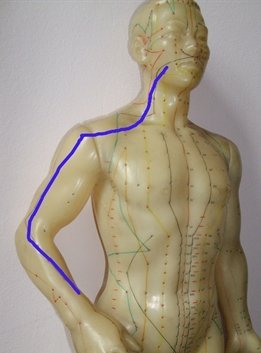
Heart and Kidney Yang deficiency
With Heart and Kidney Yang deficiency, you’ve overstressed your body’s ability to recover from over-exertion and cold.
The Large Intestine Luo channel pathway and its properties aren’t usually the first thing acupuncturists learn about, but still! … very useful when needed.
This page is a bit abstruse if you’re a beginner. It’s not that the words are any, or at least, much, more difficult than on other pages, but this is about a subject usually taught some way into acupuncture courses.
So some of the concepts need your familiarity with other ideas in Chinese medicine.
Actually, I did this page, and other luo-connecting channel pages, for me.
It means I can look up both the channel and its symptoms on my smartphone in case I forget them.
If it helps others, great.
For more information about this type of acupuncture channel, click on luo-connecting channels.

Here are the classical symptoms of imbalances in this luo channel. Of course in diagnosing these conditions, there would be other symptoms making a fuller picture, familiar to acupuncturists:
The Large Intestine Luo channel’s indications listed above are succinct. When treating someone, many more signs would be looked for to confirm the diagnosis.
For example, if Cold is suspected, one might expect the kind of abdominal pain to be like those listed for Cold. Probably the individual would either avoid, or feel better if he avoided, Cold Foods.
One would expect other corroborating symptoms as well:

So, just taking a single example from the list above, you can see that the signs given are just a reminder of what to expect.
In nearly all cases, one would include the Large Intestine luo point: Pianli, Large Intestine 6.

Stay in Touch!
No spam, only notifications about new articles and updates.

Book a Video consultation if you want to know more about your symptoms

With Heart and Kidney Yang deficiency, you’ve overstressed your body’s ability to recover from over-exertion and cold.

Why You get Nervous Stomach Anxiety and How to Handle It. Acupuncture has great ways to help.
Subscribe to the Newsletter
If you are interested in understanding how Traditional Chinese Medicine can improve your life sign up to my newsletter for the latest updates.
Subscribe to the Newsletter
If you are interested in understanding how Traditional Chinese Medicine can improve your life sign up to my newsletter for the latest updates.